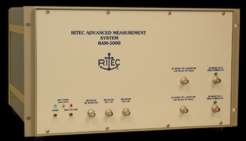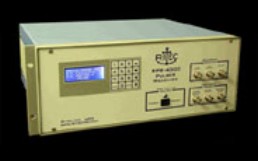
Ritec - Complete Computer Controlled Systems
Overview
- RAM-5000: Computer Controlled Utrasonic System
- SNAP: For the Study of Nonlinear Acoustic Phenomena
- RPR-4000: Computer Controlled High Power Pulser Receiver
We are exclusive representatives in Europe.
RAM-5000
Computer Controlled Utrasonic System

The RAM-5000 is a modular ultrasonic system designed to satisfy the needs of the acoustic research in materials science or advanced NDE. Its purpose is to transmit RF bursts of acoustic energy into a test piece, receive signals following the burst, and manipulate and analyze these signals in various ways. Examples include the determination of acoustic attenuation, velocity, stress, material texture, and a number of other physical properties. Gated- amplifier, high-power outputs are obtainable over a frequency range far in excess of one decade. Typical high-power (5KW) frequency ranges are 0.05 to 5 MHz and 0.5 to 7 MHz. At 1KW these ranges are extended to ~5 and just under 20 MHz respectively. The high power is particularly valuable when using electromagnetic acoustic transducers (EMATs). Various versions of the instrument may be chosen to meet the user's specific needs. The most popular configurations are the pulser-receiver and the full measurement system.
SNAP
For the Study of Nonlinear Acoustic Phenomena

In the last few years, considerable attention has been focused on using nonlinear ultrasonic properties for the nondestructive evaluation of materials. Some examples of important applications include: metal fatigue, micro cracking, bond strength of adhesives, metal embrittlement, and properties of coatings. The RITEC SNAP incorporates a number of unique circuits designed to facilitate the determination of these properties using a variety of techniques:
- Harmonic generation in the sample can be monitored as a function of the driving sound amplitude.
- Acoustic resonances may be examined at high and low amplitudes.
- Beam mixing at two driving frequencies can be studied using two high-power, gated amplifiers.
- In some cases simple amplitude dependence may used to obtain valuable results.
Gated-amplifier, high-power outputs are obtainable over a frequency range far in excess of one decade. Typical high-power (5KW) frequency ranges are 0.05 to 5 MHz and 0.5 to 7 MHz. At 1KW these ranges are extended to ~5 and just under 20 MHz respectively. In the SNAP system, however, the superheterodyne receiver may be independently tuned up to 80 MHz without loss of phase coherency.
RPR-4000
Computer Controlled High Power Pulser Receiver

The rugged new RITEC RPR-4000 Pulser/Receiver features an 8 kW tone burst pulser at up to 1% duty cycle, a 100 dB gain low noise receiver, a local display and keypad for control of all functions, and an environmentally secure package with over temperature shut-down. This remarkable instrument has been designed to withstand severe environmental pollution and high temperatures while providing the most powerful tone burst pulse available to the ultrasonic testing market. The very high pulse power is especially valuable when driving electromagnetic transducers (EMATs) which are well known for having poor sensitivity. The front panel key pad provides control of all functions including frequency, repetition rate, pulse width, receiver gain, receiver input selection, and receiver filter selection. A novel feature of the instrument is a front panel display of the peak burst voltage being generated in the pulser. Up to ten sets of operating parameters can be saved for future recall. The unit may also be controlled from an external computer via the RS-232 interface. Gated-amplifier, high-power outputs are obtainable over a frequency range in excess of one decade. Typical high-power (8kW) frequency ranges are 0.05 to 0.5 MHz and 0.25 to 2 MHz. The high power is particularly valuable when using electromagnetic acoustic transducers (EMATs) and aircoupled transducers.


